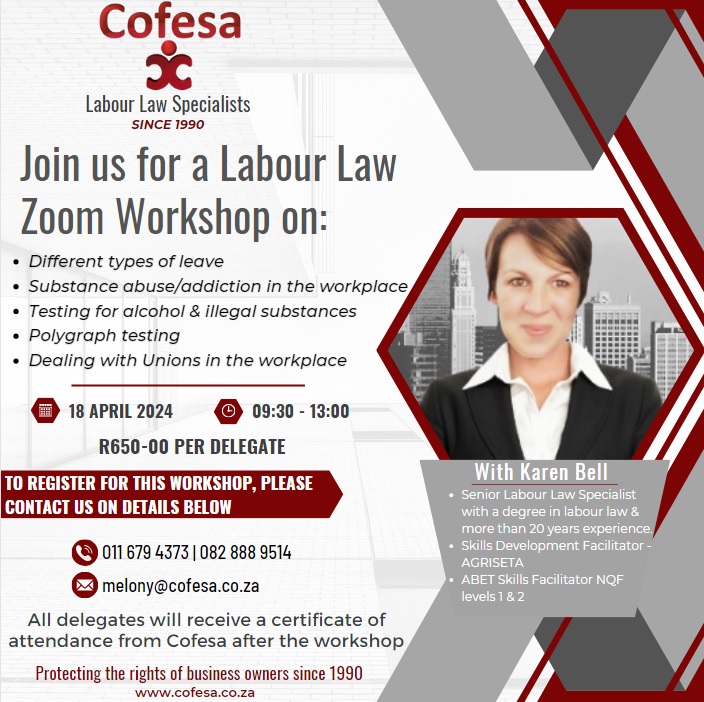Rules regulating conduct in the workplace flow from a number of sources. Some emanate from the common law, for example, that an employee may not steal from an employer. Some rules are the result of an express agreement between the parties while other rules may arise impliedly from the conduct of the parties.
There have been various forms of disciplinary offences that have been held to justify the dismissal of an employee who committed misconduct. It is, therefore, necessary that employers have rules in the workplace which their employees are aware of, and which rules are applied consistently across the workplace. An employer’s rules should create certainty and consistency in the application of discipline. Standards of conduct must be clear and made available to employees and should be written in a way which is easy to understand.
Substantive fairness of a dismissal for misconduct is assessed according to Item 7 of the Code of Good Practice: Dismissal. It states that any person who is determining whether a dismissal for misconduct is unfair should consider:
a. Whether or not the employee contravened a rule or standard regulating conduct in, or of relevance to, the workplace and;
b. If a rule or standard was contravened, whether or not –
-
- The rule was a valid or reasonable rule or standard;
- The employee was aware, or could reasonably be expected to have been aware, of the rule or standard;
- The rule or standard has been consistently applied by the employer; and
- Dismissal was the appropriate sanction for the contravention of the rule or standard.
Paragraph (a) of Item 7 requires the employer to prove on a balance of probabilities that the employee committed the misconduct and is guilty of the offence. To do this, an employer must prove that a rule existed and that the employee breached the rule or standard. To prove the rule existed, one may refer to the employee’s contract, a collective agreement or, in most cases, the employer disciplinary code of conduct. It is important to mention that rules may not always be in writing as long as the breach of the rule results in an irretrievable breakdown of the employer/ employee trust relationship. Should the employee deny the existence of the rule, an employer must prove the existence of the rule and that the employee was or should have been aware of the rule.
In respect of rules regarding adherence to company policies and work practices, it is important that these rules are placed in writing. In respect of certain work practices, employers may want to put these rules in writing and make them visible in the workplace. Rules which are visible in the workplace make it less likely an employee can deny that he/she was aware of the rule.
The importance of placing rules in writing was made clear in the case of Dikobe v Mouton NO (2016) 9 BLLR 902 (LAC) in which the employee was dismissed for misconduct after he was found guilty of being in unauthorised possession of drinks vouchers and using them to purchase drinks at the employer’s bar. The CCMA held that the dismissal was substantively fair, an award that was upheld by the Labour Court on review.
The evidence disclosed that the employee, who was off-duty, had been with a friend who the employer termed a ‘most valued guest’ and that he had used VIP vouchers issued to the guest to purchase drinks for the two of them. The employee’s case was that the guest had handed the vouchers to him in order to enable him to purchase the drinks and that the remaining vouchers were later handed back to the guest. The employee had denied that what he did was prohibited, but the commissioner had accepted that there was a rule at the employer’s workplace to the effect that employees were not permitted to possess VIP vouchers.
On appeal, the Labour Appeal Court pointed out that, even though the alleged rule had been in dispute, the employer had not proved its content, scope and effective communication. The rules handbook that had been submitted was unhelpful since the employee had not been charged with any of the rules mentioned in it. The rule relied upon by the employer was, at best, oral and, if it existed at all, it was vague in that it did not deal with several circumstances that might arise in practice. Yet, despite the lack of evidence in that regard, the commissioner had approached the matter on the basis that the rule existed.
The court concluded that the commissioner’s failure to address the question of the content, scope and application of the rule relied upon was unreasonable. It concluded further that there was no evidence of a breach of a reasonable rule and that the employee’s dismissal was therefore unjustified.
Item 7 of the Code of Good practice also refers to the reasonableness of the rule. A workplace rule can be regarded as reasonable and valid if it falls within the employer’s contractual powers and if it is not contrary to law or a collective agreement. A rule will be regarded as reasonable if it is operationally justified and serves to promote the employer’s business, and it does not impose an unreasonable burden on the employee.
Once a rule is in place, an employer must ensure that the rule is applied consistently across the workplace. The labour courts have, for many years stressed the principle of equal treatment of employees. It would be unfair to treat employees, who have committed similar acts of misconduct differently.
In Choleta v Trek Engineering (Pty) Ltd 1992 13 ILJ 219 (IC) it was held that it would be unfair to dismiss an employee for an offence which the employer has habitually or frequently condoned in the past. In Cape Town City Council v Mashito (2000) 21 ILJ 1957 (LAC) it was held that it is in general unfair to impose different sanctions on employees found guilty of similar misconduct.
In South African Labour law, there are two forms of consistency, namely historical and contemporaneous consistency. Historical consistency means that in the past each time the same act of misconduct was committed by different employees, the employer applied the same standards of measurement and followed exactly the same disciplinary procedure in each case. It would be unfair and inconsistent to dismiss one employee for the exact same offence another employee was given a written warning for. Contemporaneous or collective consistency means that where a number of employees have committed an act of misconduct at the same time, then each employee involved in the act of collective misconduct must be treated the same and by the same standard.
To succeed in a challenge for inconsistency, an employee must lay a credible basis for the claim. If such a challenge is not specifically raised, the employer has no general onus to prove that it has treated the employee consistently. Where the employee lays a credible factual basis for a claim of inconsistency, or where it is common cause that other employees had been treated differently, the onus would be on the employer to provide a plausible explanation.
In National Union of Mineworkers on behalf of Botsane v Anglo Platinum Mine (2014) 35 ILJ 2406 (LAC), The employee was charged with gross negligence relating to his failure to comply with the mine’s initiative to the installation of safety devices. He was dismissed, and his dismissal was held to be fair at arbitration. The Labour Court upheld the award, and the appellant appealed to the Labour Appeal Court. He challenged the judgment and award on two grounds, one of which is where the employee argued the sanction of dismissal was inappropriate because sanctions had been inconsistently applied to all those involved in the acts of misconduct. It was held to be problematic that alleged the presence of inconsistency was the failure to recognise that the employee alone was responsible, within his area of management control, to manage the fitment programme. Furthermore, there was no mention of a challenge to inconsistency in the pre-arbitration minutes and an employee, who believes they have a case for inconsistency, should argue the same at the start of proceedings to state such an issue openly and unequivocally so that the employer is put on proper and fair terms to address it. A challenge to inconsistency should be a concrete allegation identifying who the persons are who were treated differently and the basis upon which they should not have been treated differently.
Source: www.ceosa.org.za | Article by: Gordon Flanagan and Ruaan Heunis

